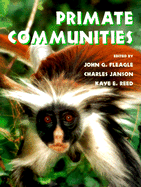Book contents
- Frontmatter
- Contents
- List of contributors
- Preface
- 1 African primate communities: Determinants of structure and threats to survival
- 2 Biomass and use of resources in south and south-east Asian primate communities
- 3 Species coexistence, distribution, and environmental determinants of neotropical primate richness: A community-level zoogeographic analysis
- 4 Primate communities: Madagascar
- 5 Primate diversity
- 6 Phylogenetic and temporal perspectives on primate ecology
- 7 Population density of primates in communities: Differences in community structure
- 8 Body mass, competition and the structure of primate communities
- 9 Convergence and divergence in primate social systems
- 10 Of mice and monkeys: Primates as predictors of mammal community richness
- 11 Comparing communities
- 12 Large-scale patterns of species richness and species range size in anthropoid primates
- 13 The recent evolutionary past of primate communities: Likely environmental impacts during the past three millennia
- 14 Resources and primate community structure
- 15 Effects of subsistence hunting and forest types on the structure of Amazonian primate communities
- 16 Spatial and temporal scales in primate community structure
- 17 Primate communities in Africa: The consequences of long-term evolution or the artifact of recent hunting?
- 18 The future of primate communities: A reflection of the present?
- 19 Concluding remarks
- Systematic index
- Subject index
5 - Primate diversity
Published online by Cambridge University Press: 21 August 2009
- Frontmatter
- Contents
- List of contributors
- Preface
- 1 African primate communities: Determinants of structure and threats to survival
- 2 Biomass and use of resources in south and south-east Asian primate communities
- 3 Species coexistence, distribution, and environmental determinants of neotropical primate richness: A community-level zoogeographic analysis
- 4 Primate communities: Madagascar
- 5 Primate diversity
- 6 Phylogenetic and temporal perspectives on primate ecology
- 7 Population density of primates in communities: Differences in community structure
- 8 Body mass, competition and the structure of primate communities
- 9 Convergence and divergence in primate social systems
- 10 Of mice and monkeys: Primates as predictors of mammal community richness
- 11 Comparing communities
- 12 Large-scale patterns of species richness and species range size in anthropoid primates
- 13 The recent evolutionary past of primate communities: Likely environmental impacts during the past three millennia
- 14 Resources and primate community structure
- 15 Effects of subsistence hunting and forest types on the structure of Amazonian primate communities
- 16 Spatial and temporal scales in primate community structure
- 17 Primate communities in Africa: The consequences of long-term evolution or the artifact of recent hunting?
- 18 The future of primate communities: A reflection of the present?
- 19 Concluding remarks
- Systematic index
- Subject index
Summary
The chapters in this section have provided a series of geographically focused reviews of the diversity of ecological communities in the four major biogeographical regions currently inhabited by non-human primates – Africa, Asia, Madagascar, and the neotropics of South and Central America. The comparative data that are available for these different regions are by no means uniform. As a result, these chapters not only offer an opportunity to compare the similarities and differences in the primate communities of these different regions, but also highlight the gaps in our current knowledge. Despite differences in the scope and focus of the different chapters, several general themes emerge in the intraregional studies found in this section.
In all of the chapters, the authors emphasized that there are very few primate communities in the world today that have not been affected in some way by human activity (see also Tutin & White, chapter 13, Peres, chapter 15 and Struhsaker, chapter 17, this volume). In addition, it is important to keep in mind that many of the sites where primates have been most thoroughly studied have often been chosen precisely because they have extremely high numbers of species and often easy access from roads. As a result all comparisons either within regions or between them need to make some attempt to take these factors into consideration.
- Type
- Chapter
- Information
- Primate Communities , pp. 90 - 91Publisher: Cambridge University PressPrint publication year: 1999
- 1
- Cited by



